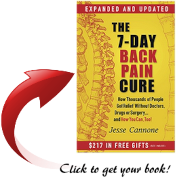On average, most of us have experienced back pain at least once during our lives, but for a group of unfortunate individuals, they have to deal with chronic pain on a daily basis. Back pain, if it’s acute, generally goes away within a few weeks. Chronic pan, according to WebMD, lasts longer than 6 months. For some, surgery is an option to get relief from the chronic condition. However, a less invasive procedure may have been discovered. Check out this article from the site The Telegraph.

Cure For Chronic Pain Found: World First As Patient Fitted With Permanent Spinal Cord Implant
Doctors in Australia have carried out a pioneering procedure to treat chronic pain, fitting a permanent spinal cord implant which can record signals from the nervous system and adjust the strength of impulses sent to affected areas.
The procedure has been hailed as a breakthrough for treatment of chronic pain and could help patients to avoid pain-killers, which can be extremely costly.
Joe Grewal, the first human to be fitted with a permanent implant, said he has suffered chronic back pain for more than 30 years and now ‘feels amazing’.”
The implant of spinal cord stimulators appear to benefit indivduals with chronic low back pain. Even though the article did not specify whether Mr. Grewal experienced low back pain, it did mention that he had experienced chronic back pain for 30 years. And the spinal cord stimulator implant appears to have decreased his pain significantly. If you recall, there were a number of topics on The Back Pain Education Day that discussed the perception of pain, and introduced the brain and back pain connection. The spinal cord stimulator lessens the perception of pain, and it achieves that with electrical impulses that produce a “pleasant tingling sensation”, confusing the brain that there’s no pain from the affected area.
I guess we should view this with cautious optimism. Its appears to be a promising procedure, and one of the advantages is that chronic pain relief is possible without relying on powerful prescription and OTC painkillers. On the other hand, this implant is the first of its kind, and so we need to wait and see what the long-term results are of such implants. And, of course, we need to be aware of the risks that come with such a procedure. The article did not mention whether Mr. Grewal explored other options to relieve his chronic pain, such as going on an anti-inflammatory diet, as recent studies have found that inflammation is a major factor in the cause of chronic pain.




